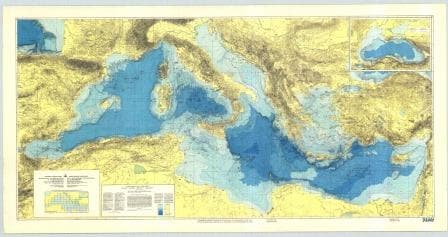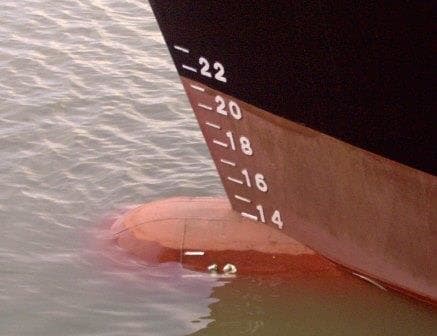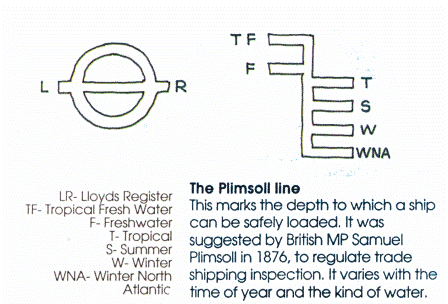We are on now on one of those stretches between ports which really do not fit in a proper cruise schedule. The distance between Malta and Crete is too far to cover in one night and for a full day at sea, you are really sailing on a slow-boat. So we are happily trundling along with a speed of 11 knots. A good thing as well, as during the evening and early morning there was a considerable amount of wind and thus quite a few bumps in the road. Had the Prinsendam been going full speed we would have noticed all those bumps in a very distinctly way. Now with a slower speed the bow rides the waves instead of bashing into them and it results in a much more comfortable ride.
 Today we are deep water. The Mediterranean Sea as a whole is not so deep. In the long and distant past, when the Oceans were lower, this area was once land and only with the rising seas this land area was eventually broken into near Gibraltar and flooded. But East of Sicily and South of Greece there are quite some considerable depths which are more normal in the Oceans than in an inland sea. As you can see from the Chart there is a deep blue triangle right in the middle of the Med. This area is called the Ionian Sea and the ocean floor dips down to over 5000 meters. (The deepest deep is the Calypso Deep with a depth of 5,267 meters or 17.280 feet)
Today we are deep water. The Mediterranean Sea as a whole is not so deep. In the long and distant past, when the Oceans were lower, this area was once land and only with the rising seas this land area was eventually broken into near Gibraltar and flooded. But East of Sicily and South of Greece there are quite some considerable depths which are more normal in the Oceans than in an inland sea. As you can see from the Chart there is a deep blue triangle right in the middle of the Med. This area is called the Ionian Sea and the ocean floor dips down to over 5000 meters. (The deepest deep is the Calypso Deep with a depth of 5,267 meters or 17.280 feet)
There is another interesting issue with the Med. One that affects in a small way the seafarer. As there is more salt water coming in, than fresh water, the Med is a little bit more salty than the oceans to which it is connected. How does affects the seafarer? Well, every ship has a draft and the draft depends on what water that ship is sitting in. Salt Water with its higher density creates more buoyancy then Fresh Water. Fresh water has a salt content of zero; we call that 1000. Regular sea water has a salt content of 35 grams per 1000 grams water or 35 parts per thousand. The Med can reach 37 to 38 parts per thousand. This means that the ships draft will reduce by the influence of those 3 extra parts per 1000 more than in the Ocean.

This is not the bow of the Prinsendam but an image plucked from Wikipedia. The Draft Marks are in Feet. Nowadays more and more ships are metric.
Although 3 parts extra is not that much, the total of 38 extra parts per thousand is considerable and it affects the ships stability. As a rule of thumb, the deeper a ship lies in the water, the more stable it is. Hence the great interest a navigation officer has in the draft. As a result a deck officer will check the draft in every port before finalizing the stability calculation for the coming voyage. In the old days we had to run around the ship, now we have digital read outs on the bridge. But as that is mechanical, it can go wrong and thus the deck officer still regularly verifies if those read outs are correct. We have those read outs (called draft marks) at the bow, the middle and at the stern. By combining all three, as the ship is not always at the same draft at the bow as at the stern, the navigator can figure out the exact displacement of the ship in the water. By checking the salinity, he/she can then exactly figure out what the weight of the ship is and thus calculate if the stability is good and if it is safe to sail.
Related to this, is the existence of the Plimsoll Mark on the side of the hull. This harkens back a number of years. In the good old days, everybody just loaded the ships anyway they wanted and some unscrupulous ships owners wanted as much as possible and on a regular basis ships sank, capsized or cracked open. And there were lots of them. A gentleman called Mr. Hall invented a measuring system so you could see on the hull if the ship overloaded or not. How deep the ship could go depended on the salinity of the water and that was indicated as well. A British parliamentarian pushed for this system to be adopted into British Law and somehow he got his name attached to it as the Plimsoll Mark. Nowadays the whole world is using it. It is embedded in Maritime Law and each commercial ship is required to have it.
Tomorrow we are in Heraklion or Iraklion, Crete. We are expecting a chilly day; same as we had today as the winds keep blowing from the north. Only tomorrow even more so. We will be docking at the passenger terminal as we are the only cruise ship expected. When we dock, there will be a lot of wind on the beam while lining up, so I expect that the captain has a few tugboats lined up. As far as I remember one tug is compulsory anyway. Courtesy of a harbor master who does not like dents in his piers from captains thinking they can do it without. Noon temperature is supposed to reach 66oF/ 19oC. But my guess is that this is out of the wind and in the sun.


April 10, 2015 at 2:37 pm
Very good Captain Albert I am glad when you help readers understand the finer points of operating ships such as draft and marks.
April 10, 2015 at 6:05 pm
Thank you for your discussion of the “Plimsoll” mark. I was aware of its existence and purpose but you supplied the history behind it. Thank you again…..Ruud in Tierra Verde, Florida
April 14, 2015 at 4:00 pm
Another thank you here, Captain. I’ve only seen the draft marks on the sides of the ships, as well as Deck Officers coming on shore to look at, I thought, the waterline not knowing what they were doing. Now I can put the looking to a more meaningful purpose!